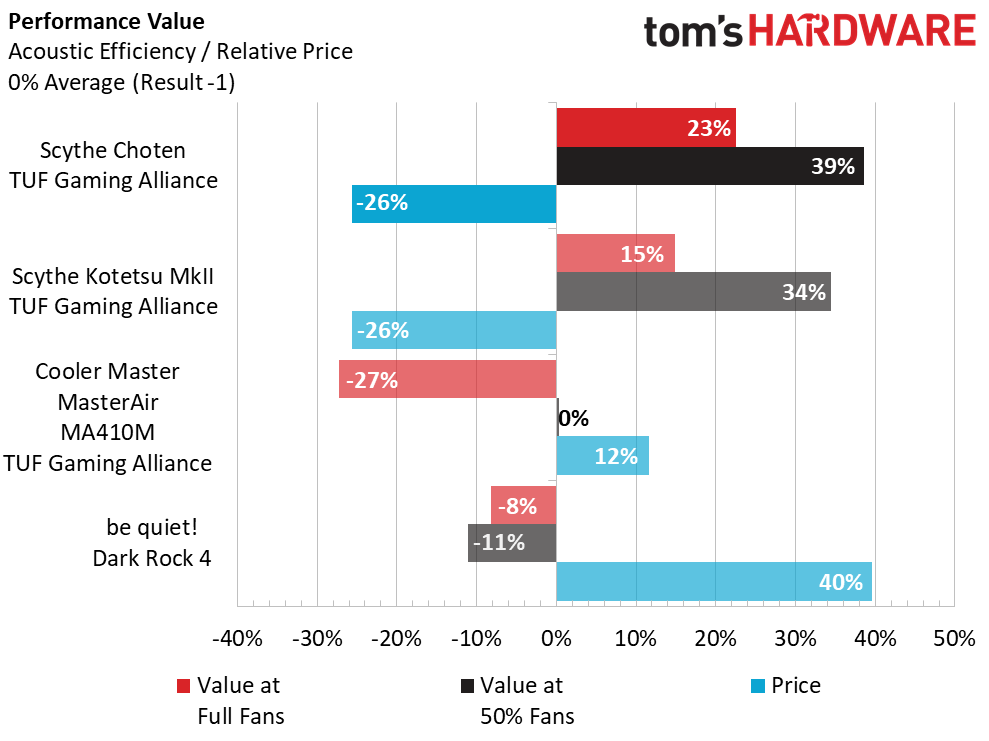Scythe Choten TUF Gaming Alliance Review
Why you can trust Tom's Hardware
Testing Results and Conclusion
One primary benefit of testing a multitude of CPU coolers is that we always have large volumes of test data on hand for comparison when we need to evaluate new components. Result data taken from our overclocked hex-core, Intel i7-5930k at 4.2Ghz and 1.20v on our MSI X99S XPower AC motherboard provides plenty of thermal load to push the limits of every CPU cooler we test.
We’ll be comparing the Scythe Choten TUF Gaming Alliance with its sibling, the Scythe Kotetsu MkII TUF Gaming Alliance, the Cooler Master MasterAir MA410M TUF Gaming Alliance and the be quiet! Dark Rock 4.
Thermal load performance of the Scythe Choten fares only slightly better than that of the Kotetsu MkII, but trails behind that of the Cooler Master and be quiet! coolers by more than 20°C.
Slower fan speeds are tracked for both the Scythe Choten and the Kotetsu MkII, both of which utilize the same 120mm Kaze RGB Kaze fan. The be quiet! Dark Rock 4 spins a 135mm fan as its primary armament. And of course, the Cooler Master MA410M utilizes a 120mm dual-fan setup, with each topping out at over 2000 RPM.
Higher fan speeds almost always result in higher relative noise levels, and the low-RPM values on the Scythe Choten TUF Gaming Alliance put it in position just barely higher than the whisper-quiet Dark Rock 4. Likewise, the twin-prop setup of the Cooler Master MasterAir MA410M shows what dual high speed fans nets you in terms of noise levels.
Even with a higher range of overall thermal results, the low noise levels benefit the Scythe Choten well enough to provide a proper balance between cooling and acoustics. The be quiet! Dark Rock 4, having the best overall thermal performance and the lowest registered noise levels of the group easily pushes ahead in our acoustic efficiency rating.
Once we factor in the low cost of the Scythe Choten ($40/£31), the chart really swings into favor for the downdraft heatpipe cooler and its sibling, the Kotetsu MkII. Both the Cooler Master MA410M and the be quiet! Dark Rock 4 take hits on our chart from having higher overall cost.
Get Tom's Hardware's best news and in-depth reviews, straight to your inbox.


Thermal imaging from our Flir One Pro shows a slight increase through the cooling tower in an almost transparent view though the top view of the Choten’s downdraft design. At 50 percent fan speeds, there is noticeable heat bloom variation through the core of the cooling tower compared to the same region with the fan set to full speed. The 100 percent view also shows more heated turbulence around the perimeter of the cooler, signifying dispersion of heated airflow from the increased blade speed.
The unique design of the Scythe Choten provides a welcome display of the inner workings of a heatpipe cooler, even if it isn’t the outright best at cooling high end desktop (HEDT) CPUs shouldered with large overclocks. However, the Choten is quite suitable for entry-level builds and moderate overclocking for most modern quad core CPUs with a stock TDP under 95 watts. The TUF Gaming Alliance theme also provides a bit of punchiness and attitude to any build, while RGB lighting allows it to mesh easily with any color theme you choose.
MORE: Best CPU Cooling
MORE: How To Choose A CPU Cooler
MORE: All Cooling Content

Garrett Carver is a contributor for Tom’s Hardware, primarily covering thermal compound comparisons and CPU cooling reviews; both air and liquid, including multiple variations of each.







